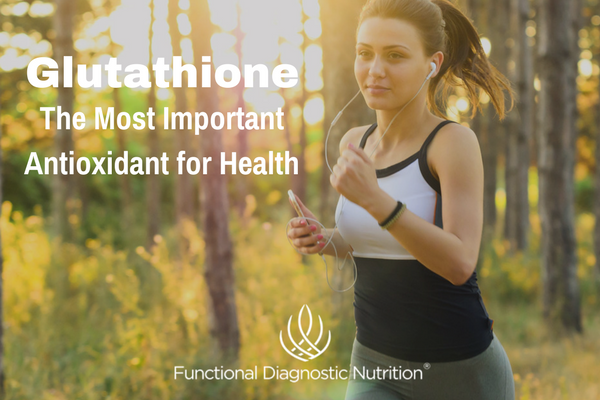There is one antioxidant that has become a focus in the health world over the past few years. And yet many health professionals still remain unaware of it’s power in helping to restore health. But you need to know about this important antioxidant, because helping your clients boost glutathione levels can help them reclaim their health and begin to feel better! That special antioxidant is glutathione!
Glutathione is often called the “master antioxidant”. And it is the most important antioxidant for preventing disease and promoting health. Glutathione is a combination of three key amino acids, l-cysteine, l-glutamic acid and glycine. Glutathione’s powerful effects on free radicals are what have made it such an important part of preventing and reversing metabolic chaos™ in the body. Free radicals are the result of oxidative stress. Oxidative stress occurs naturally after our body uses glucose for fuel, as a byproduct of the stress response, when the immune system has been fighting viruses and bacteria, and in response to the neutralization of toxins in the body.
As oxidation occurs and free radicals are produced, it cause stress to the cells. And if left in the body, free radicals can ultimately cause damage to those cells, leading to disease. Glutathione binds to these free radicals and renders them harmless. This helps to slow down the aging process and prevent chronic illness. But low levels of this powerful antioxidant are becoming more common. After the age of 20, glutathione levels naturally decrease by 10% each decade. But there are other things that we may be exposed to each day that may be further lowering glutathione levels.
Things that deplete glutathione levels:
- Artificial sweeteners
- Heavy metals
- Insecticides/pesticides
- Over the counter and prescription medications
- Alcohol
- Food additives and preservatives
- Chemicals in household cleaners
- Chemicals in personal care products
- Poor diet
- Chronic stress
- Genetically modified foods
- EMFs
- Radiation therapy
- Injuries
- Overuse of antibiotics
- Sleep deprivation
- Intense exercise
Exposure to a growing number of these things may be contributing to low glutathione levels and ultimately, chronic illness. Oxidative stress is a common issue among the clients that are typically looking to work with a health coach, personal trainer or other health practitioner. Many are already experiencing mild to moderate health symptoms. They will be coming to work will you in hopes of finding relief.
What are some of the symptoms of oxidative stress in the body:
- Fatigue, brain fog and memory loss
- Eyesight issues
- Insomnia
- Depression and anxiety
- High blood pressure
- Heart disease
- Asthma
- Allergies
- Kidney disease
- Hypertension
- Wrinkles
- Acne
- Eczema
- Psoriasis
- Muscle pain and weakness
- Diabetes
- Fibromyalgia
- ADHD
- Chronic Inflammation
- Arthritis
- Auto-immune disorders
- Cancer
Many clients will be struggling with one or more of these symptoms, and may find that the symptoms have gotten worse over time as oxidative stress has increased and glutathione levels decreased.
How can your clients protect glutathione levels in the body?
Get Plenty of sleep!
Sleep deprivation can cause oxidative stress. This happens because cortisol levels tend to remain high following an evening without enough sleep. Cortisol encourages the body to release glucose and oxidative stress is caused by glucose being used for energy. Getting adequate sleep can help to stop that pattern and reduce oxidative stress levels as well as allowing more glutathione to be available.
Exercise
Getting clients up and moving for at least 30 minutes a day can help boost glutathione levels. If they haven’t been exercising regularly, they can start slow and build their way up to 30 minutes of gentle to moderate exercise. Avoid intense exercise which can further deplete glutathione levels!
Avoid toxins
What chemicals are in the products they use to clean their home or for their personal care routine? Most likely they don’t have any idea! It is surprising, and perhaps a little frightening just how many toxins are in many products that people use every day. Exposure to these chemicals is causing toxic overload for the body and significantly contributes to low glutathione levels. The body just can’t keep up with detoxification needs. Encourage them to begin to change what products they are using. The Environmental Working Group’s website can be a great resource. They have databases for household cleaners and personal care products. And they can find products that will be much safer for their body and that don’t increase the toxic load.
Focus on Healthy Eating
Eating a lot of sugar and factory processed food produces free radicals that require a lot of glutathione to immobilize. Many of these foods are full of toxic additives and preservatives that are toxic to the body. Eating a diet with healthier whole foods, removes much of that toxic burden and helps to prevent glutathione levels from becoming depleted.
Eat sulfur rich foods
Foods such as meat, eggs, broccoli, cauliflower, kale, garlic, onions, coconut milk and oil, nuts and legumes are all rich in sulfur, which is needed to make glutathione. Adding some of these foods each day will help your clients boost their glutathione levels by supporting production!
Practice stress management!
Chronic stress and staying in an active stress response is a drain to glutathione levels. Taking the time to actively reduce stress and shut off the stress response will help to prevent depletion of glutathione. It is important for your clients to schedule time daily to practice stress management in order to preserve glutathione levels.
Helping your clients reduce oxidative stress and raise glutathione levels will go a long way to helping them restore their health and feel better!
Want to know for sure if oxidative stress is causing your clients health problems? The FDN certification course can teach you how to run and interpret functional lab tests that can show you if oxidative stress is present in your clients. You will then learn specific, targeted protocols that can help reverse oxidative stress, and reverse the issues that have been caused by free radical damage so that your clients get results! Learn more about our certification course here!







